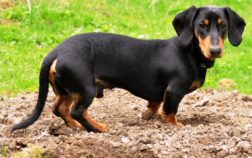Have you ever wondered about the magnificent array of colors that Dachshunds come in, especially the rare ones? In this article, we will take a close look at the captivating world of Dachshund colors, uncovering the beauty and uniqueness of these rare shades. From stunning blue and Isabella coats to the elusive piebald and dapple patterns, prepare to be amazed by the extraordinary color palette of this beloved breed. So, let’s embark on an exploration of the rare colors of Dachshunds and discover the vibrant hues that make them truly one-of-a-kind!
Overview of Dachshunds
Dachshunds, also commonly referred to as “wiener dogs,” are a unique and lovable breed that have captured the hearts of many dog lovers around the world. These small, long-bodied dogs are known for their distinctive appearance and playful personalities. In this comprehensive article, we will delve into the physical characteristics and personality traits of Dachshunds, as well as explore the different colors that can be found within this breed. Additionally, we will discuss the rare colors of Dachshunds and the considerations that come with breeding for these uncommon coats.
Physical Characteristics
Dachshunds are easily recognizable by their long, low-slung bodies, which are well-suited for their original purpose as hunting dogs. Despite their unique physique, they are surprisingly agile and possess a remarkable sense of smell. These dogs typically have short legs, a deep chest, and a strong, muscular build. Their ears are long and droopy, while their eyes are typically dark and expressive, reflecting their alert and curious nature.
There are three coat types within the Dachshund breed: smooth, wire-haired, and long-haired. The smooth-coated Dachshund has a sleek, glossy coat that lies close to the body, providing minimal protection from the elements. The wire-haired variety, on the other hand, has a rough, harsh coat that adds an extra layer of insulation. Lastly, the long-haired Dachshund features luxurious, silky fur that is longer than that of the other two coat types, often with feathering on the ears and tail.

Personality Traits
Dachshunds are known to be loving, spunky, and full of personality. Despite their small stature, they possess a bold and confident nature, often showing no fear when faced with much larger dogs. Their playful demeanor and seemingly endless energy make them wonderful companions for individuals or families alike. However, it is important to note that Dachshunds can sometimes exhibit a stubborn streak, which can make training more challenging. Patience, consistency, and positive reinforcement are key when it comes to successfully training these intelligent dogs.
Popularity as Pets
Dachshunds have gained significant popularity as pets due to their adorable appearance and friendly personalities. Their small size makes them suitable for living in apartments or smaller homes, but they still require regular exercise to prevent weight gain and maintain their overall health. Additionally, Dachshunds are known to form strong bonds with their owners, often becoming fiercely loyal and protective. Their amusing antics and loving nature make them wonderful companions for individuals of all ages, from young children to the elderly.
Common Dachshund Colors
While Dachshunds come in a variety of colors and patterns, there are several hues that are considered to be more common within the breed. Let’s take a closer look at some of these popular colorations:
Black and Tan
Black and Tan Dachshunds feature a black coat with tan markings on their eyebrows, cheeks, chest, and legs. This classic color combination is often associated with the breed and is a timeless favorite among Dachshund enthusiasts.

Red
Red Dachshunds, as the name suggests, have a solid, rich red coat. This vibrant hue ranges from a lighter, cinnamon-like color to a deep mahogany shade. Red Dachshunds are known for their striking appearance and are highly sought after by those seeking a more traditional Dachshund color.
Chocolate
Chocolate Dachshunds have a coat that resembles the color of melted chocolate. This deep, earthy shade is often paired with tan or cream markings, creating a beautiful contrast. Chocolate Dachshunds are not as common as other colors, making them a unique and eye-catching choice for those looking for a distinctive companion.
Cream
Cream Dachshunds have a coat that ranges from a pale, buttery color to a slightly darker, ivory tone. These dogs often have a solid cream coat or may have dappled or piebald patterns in combination with cream. Cream Dachshunds exude a sense of elegance and are favored by individuals who appreciate a lighter, more refined color palette.
Wire-haired
The wire-haired variety of Dachshunds can come in a range of colors, including black and tan, red, chocolate, and cream. However, their wire-haired coats give them a unique appearance compared to their smooth or long-haired counterparts. The wiry texture and rough appearance of their coat sets them apart and adds an extra touch of charm to these already adorable dogs.
Rare Dachshund Colors
In addition to the more common colors mentioned above, there are several rare color variations that can be found within the Dachshund breed. These unique and captivating hues are prized by enthusiasts and collectors alike. Let’s delve into some of these rare Dachshund colors:
Isabella
Isabella Dachshunds, also known as lilac or silver dapples, possess a striking dilute chocolate coat. The diluted pigment gives their fur a beautiful pale lavender or silver hue, making them truly stand out in a crowd. Isabella Dachshunds often have dapple patterns, further enhancing their distinctiveness.
Blue
Blue Dachshunds, also referred to as gray dachshunds, have a coat color that is a diluted, steel-gray shade. This unique coloration is a result of a recessive gene, making blue Dachshunds quite rare. Their striking appearance and cool-toned fur make them a coveted choice for those seeking a truly one-of-a-kind companion.
Fawn
Fawn Dachshunds have a beautiful, beige-colored coat that resembles the color of light sand or pale caramel. This soft and understated hue is often paired with dark eyes and a black nose, creating a delightful contrast. Fawn Dachshunds are not as commonly seen as some of the other colors, making them a captivating choice for those who appreciate a more delicate palette.
Piebald
Piebald Dachshunds have a coat characterized by large, randomly distributed patches of white on a base color. The base color can be any of the more common colors, such as black, chocolate, red, or cream. Piebald Dachshunds have a distinct and eye-catching appearance, and their coat patterns can vary greatly from one dog to another.
Dapple
Dapple Dachshunds, also known as merle, feature a mottled or spotted pattern on their coat. This pattern can occur in various colors, including black, chocolate, red, or cream, and is caused by the dapple gene. The dappling effect can range from subtle speckles to large, eye-catching patches, creating a truly unique and captivating appearance.
Isabella Dachshunds
Definition
Isabella Dachshunds, also known as lilac or silver dapples, are a rare color variation within the Dachshund breed. They possess a stunning dilute chocolate coat that has a pale lavender or silver hue. This unique coloration sets them apart from the more common Dachshund colors.
Coloration
Isabella Dachshunds have a coat that is a diluted form of chocolate. The dilution gene affects the pigmentation in their fur, resulting in a beautiful pale lavender or silver color. These dogs often have dapple patterns as well, which further enhance their distinctive appearance and make them even more sought after by Dachshund enthusiasts.
Health Considerations
While Isabella Dachshunds may be captivating in their appearance, it is important to note that this rare color variation can sometimes come with certain health considerations. Isabella Dachshunds are prone to certain genetic health conditions, including progressive retinal atrophy (PRA), a group of degenerative eye disorders that can lead to vision loss. It is essential for owners of Isabella Dachshunds to be aware of these potential health risks and provide regular veterinary care to ensure their pet’s well-being.
Blue Dachshunds
Definition
Blue Dachshunds, also known as gray Dachshunds, are a rare color variation within the breed. Their coat color is a diluted, steel-gray shade that gives them a truly distinctive appearance. Blue Dachshunds are highly sought after by those seeking a truly unique and eye-catching companion.
Coloration
Blue Dachshunds have a coat color that is a result of a recessive gene. This gene dilutes the pigmentation in their fur, resulting in a beautiful steel-gray coloration. The coat can vary in intensity, ranging from a lighter gray to a deeper shade. Blue Dachshunds often have dark noses and eyes, which create a striking contrast against their cool-toned fur.
Health Considerations
While blue Dachshunds may possess a captivating appearance, it is essential for owners to be aware of potential health considerations associated with this rare color variation. Blue Dachshunds can be more prone to certain health issues, including skin conditions and allergies. Regular grooming, proper nutrition, and regular veterinary care are crucial in maintaining the overall health and well-being of blue Dachshunds.
Fawn Dachshunds
Definition
Fawn Dachshunds are a less commonly seen color variation within the breed. They have a coat color that ranges from a pale, beige shade to a darker caramel tone. Fawn Dachshunds exude a sense of understated elegance and are highly regarded for their unique and charming appearance.
Coloration
Fawn Dachshunds have a coat color that resembles the soft, tranquil hues of light sand or pale caramel. Their fur is often uniform in color, with no significant markings or patterns. Fawn Dachshunds typically have dark eyes and a black nose, which create a pleasing contrast against their lighter coat.
Health Considerations
While fawn Dachshunds may not present any specific health considerations associated solely with their coloration, it is important to provide them with regular veterinary care and proper nutrition to maintain their overall health and well-being. As with all Dachshunds, fawn Dachshunds can be prone to certain genetic health conditions, including issues with their spines, such as intervertebral disc disease (IVDD). Being proactive in monitoring their health and providing appropriate care is essential for keeping fawn Dachshunds happy and healthy.
Piebald Dachshunds
Definition
Piebald Dachshunds are characterized by their distinctive coat patterns, which consist of large, randomly distributed patches of white on a base color. These patches can vary greatly in size and shape and can appear on any of the more common Dachshund colors, including black, chocolate, red, or cream. The piebald pattern adds an extra touch of uniqueness to these already captivating dogs.
Coloration
The base color of a piebald Dachshund can be any of the more common colors found within the breed. The patches of white, which can range in size from small speckles to large areas, create a striking contrast against the base color. The distribution and arrangement of these patches can vary greatly from one piebald Dachshund to another, resulting in a truly individual appearance for each dog.
Health Considerations
Piebald Dachshunds do not have any specific health considerations related solely to their coat coloration. However, it is important to be mindful of the potential health risks that can be associated with Dachshunds in general, such as issues with their spines. Providing proper care, including regular veterinary check-ups and appropriate exercise, is essential in ensuring the well-being of piebald Dachshunds.
Dapple Dachshunds
Definition
Dapple Dachshunds, also known as merle Dachshunds, possess a unique coat pattern characterized by mottled or spotted markings. These patterns can occur in various colors, including black, chocolate, red, or cream. The dapple gene is responsible for the dappling effect seen in their coats, resulting in a truly distinctive appearance.
Coloration
Dapple Dachshunds can come in a variety of base colors, with the dappling effect creating an eye-catching and unique pattern on their coat. The dappling can range from subtle speckles to larger, irregular patches, adding a touch of elegance and individuality to each dog. The combination of the dapple coat pattern and the underlying base color results in an array of captivating appearances.
Health Considerations
While dapple Dachshunds possess a captivating coat pattern, it is important to be aware of certain health considerations associated with this color variation. Dapple Dachshunds can be more prone to certain health issues, such as deafness or eye abnormalities. Responsible breeding practices and regular veterinary care are crucial in maintaining the overall health and well-being of dapple Dachshunds.
Breeding for Rare Colors
Breeding Dachshunds for rare colors, such as Isabella, Blue, Fawn, Piebald, or Dapple, requires careful consideration and responsible breeding practices. While these colors can be visually stunning, it is important to prioritize the health and well-being of the dogs throughout the breeding process.
Genetic Factors
Breeding for rare colors involves a thorough understanding of color genetics. These rare color variations are often the result of specific gene combinations, including recessive or dilution genes. Breeders must carefully select parent dogs that possess the desired colors and patterns, while also ensuring their overall health and genetic diversity.
Ethical Considerations
When breeding for rare colors, ethical considerations must be taken into account. It is essential to prioritize the welfare of the dogs and avoid any breeding practices that could compromise their health or well-being. Responsible breeders place a high value on the health and temperament of their dogs and ensure that proper care is provided both before and after the birth of the puppies.
Health Risks
Breeding for rare colors may come with certain health risks. Some rare color variations, such as dapple or piebald, have been associated with specific genetic health conditions, including deafness or eye abnormalities. It is crucial for breeders to be aware of these potential risks and take responsible measures to mitigate them, such as conducting thorough health screenings and genetic testing.
Understanding Color Genetics
To fully comprehend the intricacies of Dachshund coat colors, it is important to have a basic understanding of color genetics. Coat color in Dachshunds is influenced by a variety of genes that interact in complex ways, resulting in the wide range of colors and patterns seen within the breed.
Coat Color Genes
Multiple genes are responsible for determining the coat color of Dachshunds. These genes include those for coat intensity, coat pattern, and coat dilution. The interplay between these genes can produce a vast array of coat colors and patterns, from solid shades to complex merle or piebald patterns.
Inheritance Patterns
Coat color in Dachshunds follows various inheritance patterns, depending on the specific genes involved. Some colors, such as black and tan or red, follow simple Mendelian inheritance, while others, like dapple or piebald, exhibit more complex inheritance patterns. Understanding these patterns is essential for breeders looking to produce specific colors or patterns in their litters.
Selective Breeding
Selective breeding is a crucial tool in shaping the coat colors and patterns of Dachshunds. Breeders can strategically pair dogs with desired traits in order to increase the likelihood of producing puppies with specific colorations. However, it is important to remember that responsible breeding should always prioritize the health and well-being of the dogs.
In conclusion, Dachshunds are a breed beloved for their unique appearance and playful personalities. While they come in a wide range of colors and patterns, rare color variations such as Isabella, Blue, Fawn, Piebald, and Dapple add an extra layer of allure to these already captivating dogs. Breeding for these rare colors requires careful consideration of genetic factors, ethical practices, and potential health risks. Understanding the basics of color genetics allows breeders and enthusiasts to appreciate the remarkable diversity within the Dachshund breed. Whether you prefer a classic black and tan or are drawn to the elegance of an Isabella or a Blue, the world of Dachshund colors never fails to enchant.




